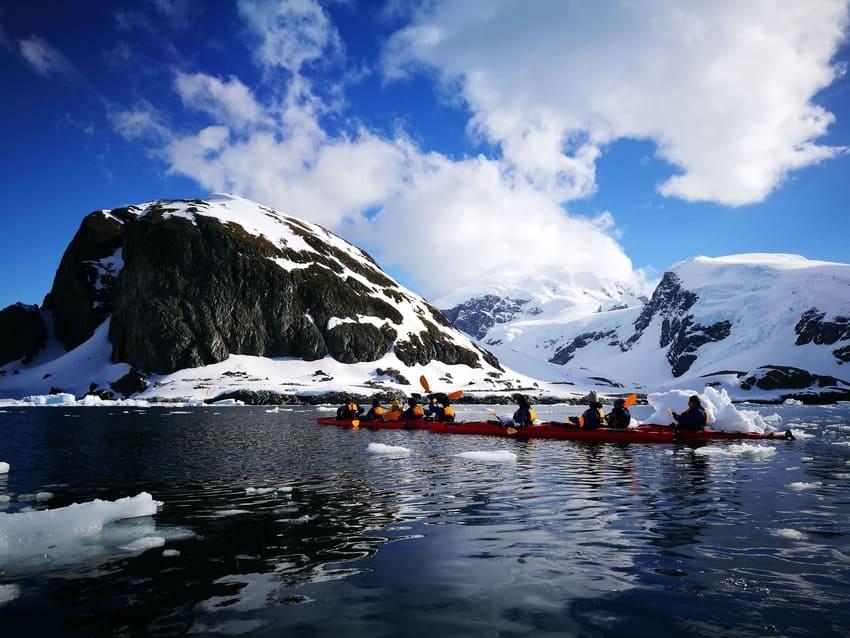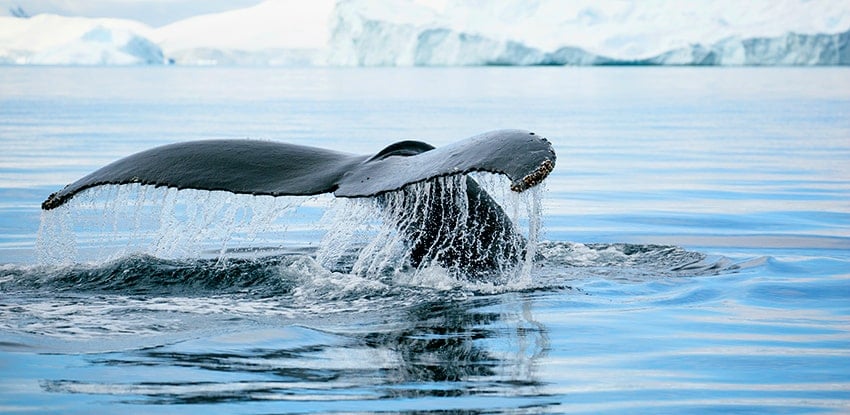How to Kayak with Whales

Paddling with Giants in Antarctica
There are few wildlife experiences as exhilarating as a close encounter with a whale. Even more incredible is meeting a whale at eye level from a kayak. Now add the beauty of the pristine Antarctic environment and you have something truly amazing. To enjoy an exceptional experience like this, you first need to book an Antarctic expedition cruise with kayaking. Whale encounters from a kayak are not necessarily closer than whale encounters from a Zodiac or the ship itself, but being down at sea level in your own kayak with a gigantic whale is a much more intimate and humbling experience. Read on to learn more about kayaking with whales in Antarctica.
When and where to paddle with Antarctic whales
The best time to encounter humpback and minke whales around the is December through March. When humpback whales arrive in mid-summer, they are hungry after months of fasting at their winter breeding grounds. They feed voraciously around the clock on bountiful krill in the calm waters of Gerlache Strait. As summer advances and sea ice recedes, humpback and minke whales move farther into waterways such as Paradise Bay, Neko Harbour, Errera Channel and many others. In these protected bays and channels, kayakers have the best chance of encountering these magnificent creatures.
In February and March, after months of feeding, whales become more and more docile. Late in the season, as expected after a huge meal, humpback whales can be found resting or swimming slowly at the surface. They also seem to become more inquisitive during this time. Minke whales are more often on the move and harder to spot, but experienced kayak guides can find them among the icebergs by listening for their blows across the still waters.

Safety around whales
Kayak guides are often asked if whales pose a danger to kayakers. Whales are massive, powerful and fast, but they are not naturally aggressive toward boats or people. Even killer whales are not known to attack kayaks. It is also extremely unlikely that a whale would accidentally collide with a kayak. Though they may seem like lumbering giants, they are in fact highly intelligent and coordinated animals with total situational awareness and perfect control of their movements in the water.
However, as with any large animal, a dangerous situation may develop if interactions with whales are not handled with respect and caution. The International Association of Antarctic Tour Operators has developed whale-watching guidelines that apply to kayakers. Firstly, kayakers must stop their approach at a distance of 330 feet (100 meters) from whales. It is normal for inquisitive whales to approach kayakers closer than this limit, but the whales should be in control of the distance. You must never chase or harass whales in any way. Kayakers should also stay together so as not to surround, separate or scatter a group of whales, particularly mothers and calves. When close to whales, you should avoid sudden movements and keep noise to an absolute minimum. If the whales appear to be disturbed by your presence, then it is time to retreat slowly and quietly. Always heed the instructions of your kayak guides, who will make sure these and other guidelines are followed. In this way, kayakers and whales will enjoy a pleasant and safe mutual encounter.
In addition to possible whale encounters, can meet penguins and seals face-to-face in a wild polar environment full of icebergs and stunning scenery. as an optional activity on cruises to Antarctica aboard its luxury expedition ship Sea Spirit. Spots are limited and sell out quickly, so act fast to book your Antarctic kayaking adventure. The whales are waiting!